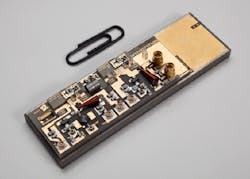Bose-Einstein condensate successfully created in space for the first time
For the first time ever, a cloud of ultracold atoms—a Bose-Einstein condensate or BEC—has been successfully created in space onboard a rocket. The researchers say that the MAIUS mission demonstrates that quantum optical sensors can be operated even in harsh environments like space—a prerequisite for finding answers to the most challenging questions of fundamental physics and an important innovation driver for everyday applications.
RELATED ARTICLE: Bose-Einstein condensate experiments to be conducted in space
According to Albert Einstein's Equivalence Principle, all bodies are accelerated at the same rate by the Earth's gravity, regardless of their properties. This principle applies to stones, feathers, and atoms alike. Under conditions of microgravity, very long and precise measurements can be carried out to determine whether different types of atoms actually "fall equally fast" in the gravitational field of the Earth—or if we have to revise our understanding of the universe.
As part of a national consortium, Ferdinand-Braun-Institut, Leibniz-Institut fuer Hoechstfrequenztechnik (FBH), and Humboldt-Universitaet zu Berlin (HU) now made a historical step towards testing the Equivalence Principle in the microcosm of quantum objects. In the MAIUS mission launched on January 23, 2017 a cloud of nano-Kelvin cold rubidium atoms has been generated in space for the first time ever. This cloud was cooled down with laser light and radio frequency electrical fields so that the atoms finally formed a single quantum object, a BEC.
Back in 1995, living room-sized setups in a special laboratory environment were required. But today's quantum optical sensor is as small as a freezer and remains fully operational even after experiencing huge mechanical and thermal stress caused by the rocket launch. This groundbreaking mission is a pathfinder for applications of quantum sensors in space.
For this mission, the FBH has developed hybrid micro-integrated semiconductor laser modules that are suitable for application in space. These laser modules, together with optical and spectroscopic units provided by third partners, have been integrated and qualified by HU to provide the laser subsystem of the scientific payload. The results of this mission coordinated by Leibniz Universitaet Hannover do not only prove that quantum optical experiments with ultra-cold atoms are possible in space, but also give FBH and HU the opportunity to test their miniaturized laser system technology under real operating conditions.
The MAIUS mission is supported by the German Space Agency (DLR) with funds provided by the Federal Ministry of Economic Affairs and Energy and tests all key technologies of a space-borne quantum optical sensor on a sounding rocket: vacuum chamber, laser system, electronics, and software.
The compact and robust diode laser system for laser cooling and atom interferometry with ultracold rubidium atoms has been developed under the leadership of the Optical Metrology Group at HU. This system is required for the operation of the MAIUS experiment and consists of four diode laser modules that have been developed by FBH as hybrid-integrated master-oscillator power-amplifier (MOPA) laser modules. The master laser is a monolithic distributed feedback (DFB) laser which is frequency-stabilized to the frequency of an optical transition in rubidium and generates spectrally pure and highly stable (1 MHz linewidth) optical radiation with low output power at 780 nm wavelength. The three other laser modules feature a tapered amplifier chip with a ridge waveguide input section. These tapered amplifier chips boost the optical output power of a DFB laser to beyond 1 W without any loss of spectral stability.
Two additional redundancy modules were integrated. Free space acoustooptic modulators and optical components are used to generate the laser pulses according to the experimental sequence. The laser light pulses are finally transferred to the experimental chamber by optical fibers.
Furthermore, a laser technology demonstrator designed for future missions has been integrated, consisting of two micro-integrated semiconductor laser modules developed by FBH. These modules are specifically required for future atom interferometry experiments that pose more stringent requirements on the spectral stability of the lasers.
SOURCE: Ferdinand-Braun-Institute; http://www.fbh-berlin.com/en/press/press-releases/detail/quantum-optical-sensor-for-the-first-time-tested-in-space-with-a-laser-system-from-berlin-1

Gail Overton | Senior Editor (2004-2020)
Gail has more than 30 years of engineering, marketing, product management, and editorial experience in the photonics and optical communications industry. Before joining the staff at Laser Focus World in 2004, she held many product management and product marketing roles in the fiber-optics industry, most notably at Hughes (El Segundo, CA), GTE Labs (Waltham, MA), Corning (Corning, NY), Photon Kinetics (Beaverton, OR), and Newport Corporation (Irvine, CA). During her marketing career, Gail published articles in WDM Solutions and Sensors magazine and traveled internationally to conduct product and sales training. Gail received her BS degree in physics, with an emphasis in optics, from San Diego State University in San Diego, CA in May 1986.
